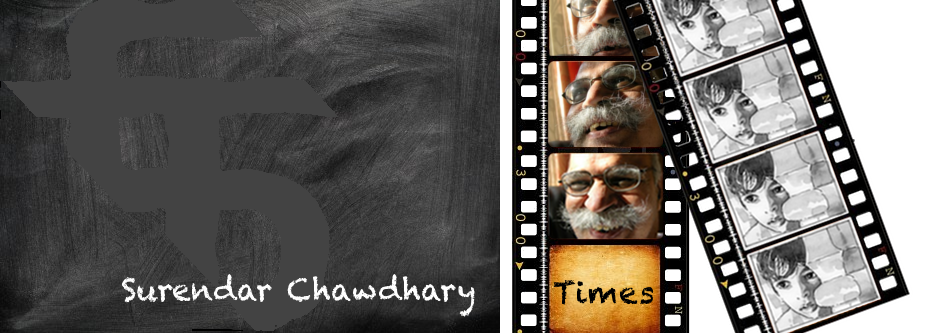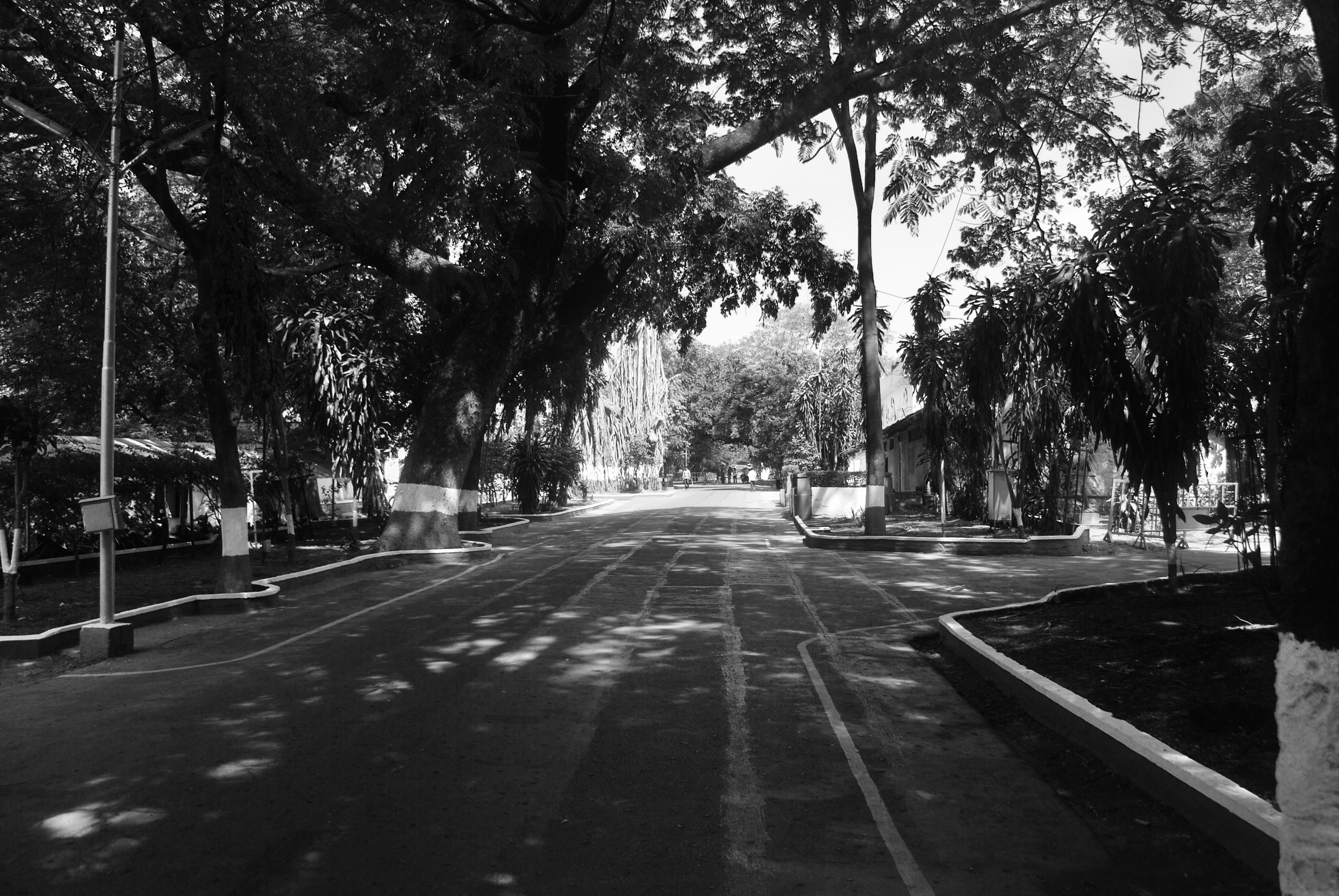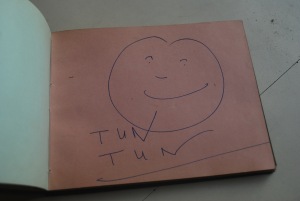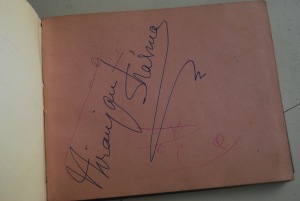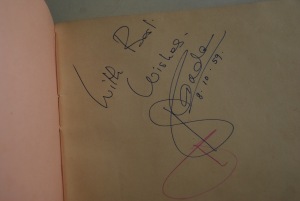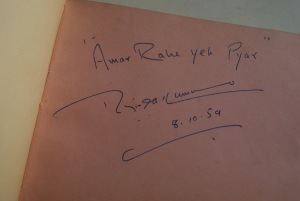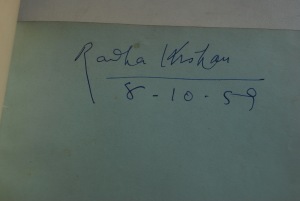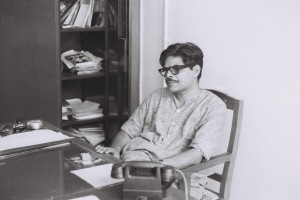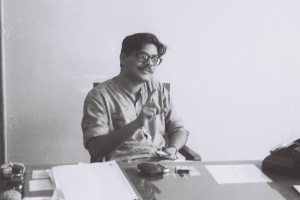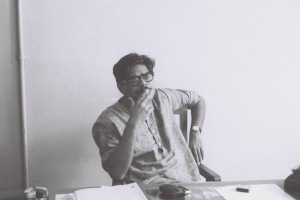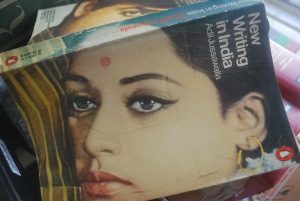Tags
Abrahim Alkazi, Adoor Gopalakrishnan, Alternate Cinema, Arun Khopkar, Arvindan, Balu Mahendra, Basu Bhattacharya, Basu Chatterjee, BK Karanjia, Dengzongpa, Elipattayam, Girish Karnad, Girish KG, Gobardhan Asrani, Govind Nihalani, Hrishikesh Mukherjee, Jaane Bhi Do Yaro, Jabbar Patel, Jahnu Barua, Jaya Bhaduri, John Abraham, Karun Shaji, Katha Don Ganpatraonchi, Ketan Mehta, KG George, KK Mahajan, Kumar Shahani, Kundan Shah, Mahesh Bhatt, Mani Kaul, Mithun Chakraborty, Mrinal Sen, MS Sathyu, Nayi Narelu, New Cinema, New Wave, Nirad Mohapatra, Parallel Cinema, Professor Satish Bahadur, Richard Attenborough, Saeed Mirza, Samskara, Satyajit Ray, Shabana Azmi, Shatrughan Sinha, Shyam Benegal, Suresh Oberoi, Uski Roti, Vijay Tendulkar, Vinay Shukla
Warning: This is not an exercise in praising our famous men.
Even though I use a lot of close ups, “Once upon a time, long long ago…” should be the tone and tenor of this account from about 50 years back.
Critics and commentators gave it fancy names such as New Wave, New Cinema, Parallel Cinema, Alternate Cinema and the rest but looking back it was nothing more sexy than a sarkari program to promote Indian films, which sadly failed. Much in the manner of our Olympic tallies, Indian New Wave would never qualify beyond an also ran rating in the History of Cinema.
Satyajit Ray dawned upon the Indian scene within years of Independence and soon the world wanted to know what else Indian cinema had to offer. But we had only our star-driven song and dance dramas. Clearly, running away from home wasn’t the best way to join the profession and Jawaharlal Nehru’s soviet leaning government of the day decided to act. Over the early 60s started a number of government initiatives: a film school in Pune (then Poona) called Film Institute of India (today’s FTII); its adjunct next door by way of a film library, National Film Archive of India (NFAI); International Film Festivals of India (IFFI and its non-competitive variant Filmotsav) as our windows to the world and a scheme of National Film Awards to single out our own artistes and technicians. In 1965 came the Film Finance Corporation (today’s NFDC) to break the monopoly of shady moneylenders and grant easy loans to promising new filmmakers.
Mrinal Sen had made films before but his FFC financed Bhuvan Shome (1969) is considered as the first film of the Wave. Check out the beauty on your laptops. And while there, check also Mani Kaul’s Uski Roti, Basu Chatterjee’s Sara Aakash, Kumar Shahani’s Maya Darpan, Shyam Benegal’s Ankur and Adoor Gopalakrishnan’s Swayamvaram. All these films are supposed to be classics of the Wave. Those that had been tone deaf to the basics of the medium had gone about arguing that they were experimenting—so all laffazi and no accountability—while others struggling with regular narration produced nothing but bumpy rides. Most of them were adaptations but that had nothing to do with the makers’ love of literature. The nudge had come from FFC whose bureaucrats, anticipating auditors’ objections to giving away government funds to nobodies, had come up with this jugalbandhi idea. If a certain Kumar Shahani had failed, so had the Hindi literature’s stalwart Nirmal Verma on whose story the young man had banked.
With similar foresight the government had appointed Filmfare editor BK Karanjia as head of the FFC. For along with Karanjia came the goodwill of the vast empire of Times of India, whose critics—and in time those of other magazines too—made it a mission of their otherwise staid careers to promote what promised to be an alternative feed to Bollywood. The same critics later flew to European festivals and sent back glorious accounts of how those festivals had begun to spin around Indian films and delegates. (All intended, again, for the ministry files and eventually the auditors.) Foreign critics, on their part, saw the Indian government’s backing to the campaign and became regulars to our own annual IFFIs and Filmotsavs. Legend Derek Malcolm of The Guardian I remember was one such.
In early 80s, Indira Gandhi got NFDC to co-produce Richard Attenborough’s Gandhi and for the first time the agency made money. But they had no solution for our own deadlocked situation where loan applications had kept piling alongside hundreds of unreleased cans. Let’s have Art theatres, screamed the young masters in the general direction of Delhi. (As if Art theatres were going to pay money to see poorly made films rather than charge!) Let’s have stars, began to ‘suggest’ NFDC to the new applicants instead—surely chocolate ones are not the only ones there are, are there? Let’s have songs and dances, they said—Indians don’t just brood but also have fun in real life, don’t they? The prodding resulted in some Om–Naseer–Faroukh–Palekar starrer middle-of-the-road films but nothing durable. The loans were eventually written off by playing the films late nights on Doordarshan.
The agony came to an end in a completely unexpected way. Stole in the brilliant Iranian cinema and took away the international limelight. Unlike our laboured produce, Irani films rang like a bell and the world heard in awe and respect. “Sir, have you seen the Irani packet?” gradually began to ask our old boys entering or exiting festival theatres invoking the Institute’s culture of film appreciation. “No, I am looking at your films!” would be my seething response, aloud or muttered. The Iranian sweep left our apologists with no listeners. We had simply been outclassed.
For the record, Arun Khopkar’s Katha Don Ganpatraonchi (1995) has to be counted as the last film of the Wave after which nobody applied for the honours. Combining the worst of Hindi cinema and Marathi theatre—you may like to go back to your laptops—the film had everything that Khopkar had cocked a squeaky snook at all through his 30 years in the medium, starting with acting in a Mani Kaul film, training 3-years at the Institute and then master-classing the rest of his time in his alma mater and elsewhere.
Runaways from home would have done a better job.
><
Adoor Goplakrishnan, Mani Kaul, Kumar Shahani, Shatrughan Sinha, (Gobardhan) Asrani, John Abraham (not the Bollywood actor), KK Mahajan, Balu Mahendra and AK Bir were my seniors and could have ragged me when I joined FTII in 1968. Nirad Mohapatra, KG George and Vinay Shukla (as indeed Jaya Bhaduri and Dengzongpa among actors) were classmates and roommates, as well as partners in crime if ever we needed to commit one. Girish KG, Karun Shaji, Jahnu Barua, Ketan Mehta, Kundan Shah and even the elderly Saeed Mirza (along with Shabana Azami, Mithun Chakraborthy, Naseeruddin Shah, Om Puri, Suresh Oberoi, Zareena Wahab and many others) came later when Nirad and I were already teaching. We were of course dealing with only the Direction students.
Mrinal Sen, Basu Chatterjee, Basu Bhattacharya (Teesri Kasam), Hrishikesh Mukherjee, and Abrahim Alkazi as head of NSD visited the Institute as governing body members or members of this or that panel. Even Karuna Bannerjee I’ve seen feature in some old photographs of the official meetings. Shyam Benegal was already an established ad filmmaker of Bombay before he broke into the New Wave but Govind Nihalani apprenticed with him before he took to directing a series of theatre-powered, socially significant films. Jabbar Patel led his Theatre Academy troupe to filmmaking on the strength of their stunning production of Vijay Tendulkar’s—no, no relation of the cricketer—Ghashiram Kotwal. (The original Marathi production of the play may well be the Pather Panchali of Indian theatre, so good it was.) I don’t think Arvindan ever came to the Institute. He was just too quiet for either workshops or councils. Our students had pointed him out to me one night sitting at the end of a crowded table at a toddy shop in Trivendrum. As a talented cartoonist who was planning to make a “filim”.
Satyajit Ray visited the Institute altogether twice, once before the Wave in 1968 and a second time in 1974 when Girish Karnad invited him to address the convocation. A couple of years before he had written a long analysis piece in Filmfare titled An Indian New Wave? spelling out genuine experimentation in the context of world cinema but FFC-NFDC circles behaved as though duty bound to criticise him. Eager now to prove themselves more faithful than their kings Mani and Kumar, students saw the ‘74 visit as a godsend. The historic Classroom Theatre was the venue and Professor Satish Bahadur in charge. Half an hour into the session the students began to jeer and heckle. Over the next hour or so a very surprised Ray just about managed to maintain his famous cool without yielding space.
Or indeed sense of humor. I can still see him sitting large and solo, patiently answering cheeky questions—“Sir, have you seen the film Gupt Gyan?”—while taking an occasional drag at his long Rothmans, which many of us secretly wished were dangling from our lips.
He knew of the crude ‘sex education’ film but said he hadn’t seen it. “Have you seen it?” he returned to the questioner after a pause, drawing a burst of laughter. “Has it been an enlightening experience?” he chuckled. More laughter and cheering.
Next day he inaugurated the new TV studios, recorded therein an inaugural interview with Professor Bahadur and sat answering through two more sessions with the spent out students. But it was clear to everyone attending that we had been ticked off from any further visits. Two years later, he concluded the India section of his book Our Films, Their Films with an article Four And A Quarter in which he lambasted Mani and Kumar films that the students had dragged him to discuss and was done with both FTII and the Wave for good.
In his later years Professor Bahadur would often burst out at the ‘wastrels’. “All that Satyajit has to do to make them happy—,” he would suddenly raise his voice in bitter sarcasm, “—is fail! But the man simply refuses to oblige!” He was spot on. If you have to try to pull down a maker of 10 classics of world cinema (the count at the time) in order to make yourself look good, you can’t have very far to go.
Bollywood remained an insulated ecosystem—Planet Bollywood?—all through the New Wave years and we in the Institute loved to hate them. The annual IFFI giving away Golden and Silver Peacocks in Delhi alternated with its non-competitive variant called Filmotsav held in Bombay, Calcutta, Madras, Hyderabad, Bangalore and Trivandrum on rotation. But a section called Indian Panorama was a fixture on both versions in which the latest crop of New Wave films were shown. That Bollywood should have no representation in what called itself panorama was first noticed and pointed out by foreign delegates but by that time the Wave itself was waning.
It was as recent as 1995 when for the first time an industry-walla like Mahesh Bhatt was appointed as FTII chairman. Given that he had made offbeat films like Saaransh and Arth (and could argue equally well with passion and conviction—and, no less, in convent English), he would easily qualify as an ex-FTII except that he happened to be courting Parveen Babi at the time. But seeing him enter the conference room for his first meeting with the faculty was an eye-opener. Accompanied by the Institute officials and going past the waiting us as he traversed the long conference table to sit at its head, I could see his knees knocking. Audio-visually so! Such was the terror that the New Wave and its Mecca FTII had managed to generate in the film industry.
That after an hour he left the room a roaring lion should be another story for another occasion.
><
Film prints in those early days travelled rough care of Indian Railways but New Wave films came to us riding the iconic Bombay-Pune-Bombay taxis as prized pets with their makers. Projectionist Kokje would collect the metal trunk in front of the Main Theatre and announce the screening in flowery colour chalks for 5.30 PM. As excited students surrounded the filmmaker under the Wisdom Tree, his suitcase would be reached to one of the Guest Rooms above the row of production offices lining the large Studio 1. These in Prabhat days used to be stars’ makeup rooms and were now a status symbol of sorts to stay in. Their large flawless imported Belgian mirrors were still in place so that ten of us sitting in the room after the film eating and drinking with the filmmaker would look twenty by the time we left doddering in the early hours of the morning.
This was the atmospherics in which our Main Theatre screen saw pretty much everything that the Wave came to offer. But on the same screen we had been seeing examples from world cinema and I can’t remember a single Wave film that ever came close. Within minutes you began to see glaring mistakes. Why was the shot still going when it had nothing more to offer? Why were they all morose, dull and dejected on the screen? Why was everybody speaking ‘literature’? And why were they speaking in a grazing-your-ear perspective when the characters were at a distance, indeed often in the long shot? What were those gulping sounds and grainy grunts in aid of? After all the scene wasn’t about the sensitivity of the recording equipment?
That’s where meeting filmmakers afterwards was an even more crowded affair. And that is where Mani Kaul scored higher than anybody else. He carried a large bamboo flute in those days, spoke of a certain ustaad and a gharana in the interiors and let it be known that he had also been painting in Akbar Padamsee’s studio. Even acting course students, otherwise immune to the goings on outside of their department, wanted to see the man who had dared you to leave the hall if you didn’t like his Uski Roti. His wit, charm and humour, delivered with consistently high degree of arrogance sent you either walking out in impotent rage or turned you into a ‘female’ for life. Even when you discovered that he was more into preaching than talking about the film we just saw, it made no difference. For indeed you were there for the man, not the film. Considering that he leaves behind a number of clones that carbon-copy his method and manner to this day, Stockholm Syndrome is the only way I can explain the phenomenon of Mani Kaul.
Kumar Shahani was all curled up and constipated by comparison. For one, he was always on protesting mode. As though in firm conviction that great cinema has to be extracted out of the system rather than just gone ahead and made. He wanted to experiment in colour when FFC was in the B&W phase, and put forth impossible conditions to resume after his second film—a 3-hour long torture in Cinemascope—remained stuck in production for years. When named in the early 80s a member of the governing council under Shyam Benegal, he went in a sulk; he would neither accept, nor refuse the nomination. His sessions, soft-spoken and delivered with French-leaning scholarly airs, were laced with Marxist references that had nothing to do with his films but were stinging curt like poisonous darts. Even so he had cultivated a band of diehard followers who would advance his cause—and he theirs—in outrageous ways. His 2-page entry in the British Film Institute published Encyclopedia of Indian Cinema counts it as one of his achievements that NFDC “failed to grant him a second loan” for such and such number of years.
Ever seen two godmen in the same frame? Not Mani and Kumar either. Although batchmates from the Institute, both took care not to be seen together in public as an unspoken strategy. I don’t know how they managed it but I’m prepared to wager a month’s pension to whoever can show me a picture of the two together.
The lesser mortals of the Wave would quickly take to either narrating production gossip or name-dropping film equipment in their ‘viva voce’ with the students. Shyam Benegal and Adoor Gopalakrishnan wore benevolent smiles as though in kind concession for the still-learning students. Mrinal Sen could ramble on for hours in his trademark stiff-starched kurta-pajama and mischievous smiles without saying anything. MS Sathyu on the other hand was so self-effacing that I don’t even remember him around after seeing his Garm Hawa. Basu Chatterjee of course couldn’t hold the pretense of discussion for longer than a minute and fizzled out into mumbles and giggles at the earliest. In any case, his films needed no defending.
That should serve as a profile of the pioneers of the Wave. Some coming later, it has to be said, made much more accomplished films but they were always in awe of their larger than life seniors. Both however were one film wonders and none ever repeated their miracles.
><
During the Corona confinement a friend suggested that I update myself on Girish KG and sent a link of her own favorite Nayi Narelu (2006). Even otherwise Girish is a worthy candidate for attention because he is one of the few still active from the New Wave and a mere mention of his name can send Kannadigas weak in the knees. Tantalizingly, Nayi Narelu is based on reincarnation and I gave it my best shot.
A young man claims to remember his past life. The head of the family he names in the next village dismisses the notion but his ailing wife insists on getting “my son” over for a few days. Then, as the old woman indulges herself feeding and even bathing the deranged 20-year-old like an idiot, she pushes her late son’s widow—supposedly his mother’s age but plump and glamorous—to play the wife as well. The woman is at first suitably horrified but a scene later is already wallowing in shringaar rasa and, without even so much as being touched, conceives…
The film is all wisdom and no common sense. Everybody wears a troubled look and goes mouthing homilies every now and then. (Fellow Kannadiga Girish Karnad was the pioneer of this style of acting from Samskara.) I was constantly ahead of the narration and kept returning to check if anything of significance might have been slipped under heavy local color: sorcery, village elders’ meet (where all behave like morons), puja rituals (copper and brass dominating), a Baby Austin that keeps wobbling in and out bringing the widow’s (oversized) daughter from the city, long boat rides grazing through lush greens, period-look police station, period-look courtroom, the works. But by the end of the drill there’s neither a satisfying story nor a view on reincarnation.
After a whole career of attempted Yorkers, Girish remains an expert at failed humor. The reincarnated husband giving away fistfuls of red chilly to the rowing, giggling boat-girl, three times over for three days’ supply, adds up not to your intended wit but poorly copied scenes from the festival circuit. One glance at the re-born and you know he’s touched in the head but nobody notices. They couldn’t all be dumb a couple of generation back in the Kannada villages?
And yet Girish is pressed for shelf space in his home for national awards. He must be the least bad of the rest.
On the same steam I decided to revisit Adoor Gopalakrishnan’s Elipattayam (1982). The film was rated as a high point of the Wave in its days but 40 years later I couldn’t go beyond an early part where the main character sits shooing away a cow that has strayed into his courtyard. Unbelievably, what enters and exits a cow in the long shots becomes a colourfully bridled bullock closer by. The editor tries his best to fudge and city dwellers may not tell the difference but this can’t be the stuff of great cinema. Not a bad film otherwise but is that good enough for the crowning glory of a Wave?
A simple approach to filmmaking is not the same thing as an easy way out approach. It’s not about “giving free hand” to technicians; they don’t want it, they don’t need it. (In fact the best of them would be happy to slave for directors who know their job.) As self-confessed Ray admirers both Girish and Adoor fool no one when they praise his humanism and stop there. That would be just parroting the critics’ coinage. Ray’s grip on the technique should be more the filmmakers’ interest and concern, for which they seem to have no head.
“If you see Bicycle Thieves from that point of view—how the shots are cut, and how the camera is deployed, and how the main continuity of background action is maintained over the shots, you’ll be amazed,” Ray told us during his troubled 1974 visit. “But, nobody looks at Bicycle Thieves from that point of view. Everybody looks at it from, the point of view of how a story of poverty, in Italy, of post-war Italy is portrayed on the screen….” Adoor for one could have greatly benefited from taking a fresh look at Ray’s Aparajito where a cow keeps straying in and out of the frame half a dozen times without looking in any way false or heavy handed.
My last port of call in the exercise was another holy cow of the Wave, Jaane Bhi Do Yaro (1983).
Interestingly, the only moulds Mani and Kumar duo had left un-experimented upon were the comic and the erotic. The reason is obvious; both demand a verifiable, even measurable audience response—enjoy the pun—that is difficult to argue out of. After all you can’t experiment on comedy and not have laughter; on erotica and not have arousal.
In JBDY, Kundan Shah decides to take the comedy bull by the horns. His approach, however, is infantile. Take the cheapest-to-stage gags from the great clowns of silent cinema, people them with fresh NSD and FTII actors and let them drag a dead body through Bombay. When the film failed to tickle ribs, the bhakts explained it away as Black Comedy and sealed the issue shut by declaring it a Cult Classic. Seen today, JBDY has only nostalgic value of how crude and clumsy latter day charmers were as they started off. Gawky versions of Naseeruddin Shah, Om Puri, Pankaj Kapoor, Neena Gupta, Satish Shah, Ravi Baswani, Satish Kaushik, Bhakti Barve are all walking in and out of the scenes here.
Twinkle, Twinkle Little Stars would be the next best title for this famous film.
___________
